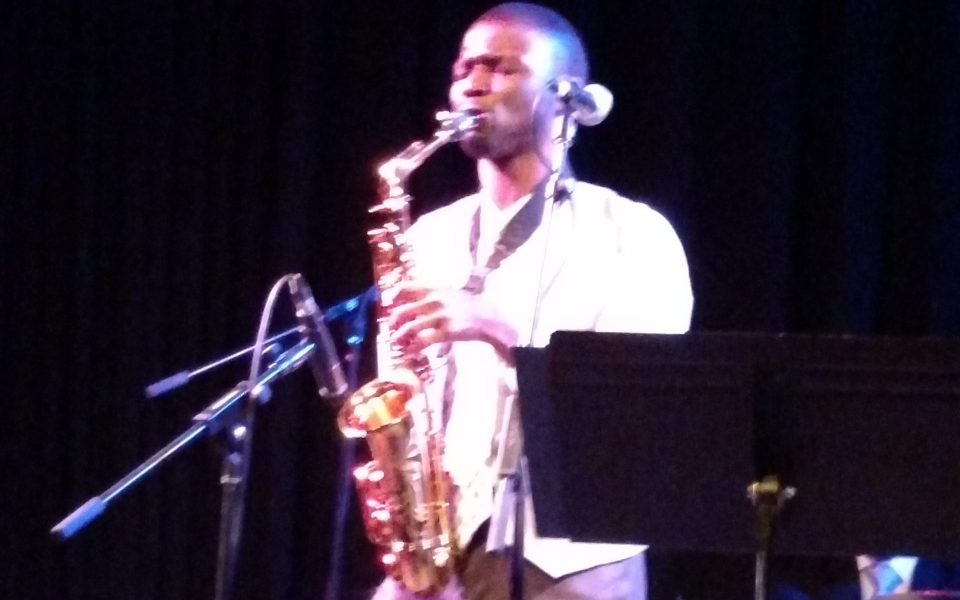The warm, mellow lights held him in an aureole, glowing and shining down at centerstage, as his fingers danced along the brassy keys. The tips of the drummer’s sticks bounced in a classic swing pattern on the cymbals, faster and faster, a smile creeping across the faces of the three musicians as Titus Gant glided into a solo.
The Crown, an upper-room venue above the Carolina Theatre in Greensboro, held a mood that felt like being transported to the past. The audience sipped on cocktails and snapped fingers between the musicians’ solos at circular tables gathered close around the stage, lacking only the noxious haze of cigarette smoke from the old jazz clubs of the Beat Generation. And the normal distance between performer and audience was killed as the first set ended and Gant stepped off stage and walked among the crowd. Shaking hands and talking with those in attendance, the beloved musician showed a humble and meek side as he spoke with fans and thanked each one individually for coming out to the show.
“I just like connecting with the people,” Gant said. “They come out to see me and so I want to meet them.”
Titus Gant, leader of the jazz quartet, has local ties from studying for his post-graduate music degree at NC Central University under the guidance of renowned jazz musicians Brian Horton, Joey Calderazzo and Branford Marsalis. The quartet comprises Titus Gant on saxophone, Drorester Alexander on piano, Lawrence Peoples on bass and Charles Pinckney on drums. This show marks Gant’s initial effort for a regular showcase of jazz music in Greensboro.
“I want this to be a monthly event,” Gant said. “The more people that come out, the lower the ticket prices become. There is a lack of jazz in the community and I believe there is a need and want for it.”
Gant’s music recalls moments of instrumental expertise known mostly for such legends as John Coltrane and Art Blakely. But while his own talents remain among the upper echelon of jazz artists in the Triad, Gant had a special surprise ready for the audience at the Crown.
As the quartet’s drummer, and Gant himself, cleared the stage, three of Gant’s private students shyly made their way towards the front. Two performed on the saxophone and one held down the beat on drums in the background. The audience gave an elated applause at the sudden change of cast for the show, recognizing what Gant was promoting. The students struggled at first, barely audible, playing as gently as possible. He encouraged and showcased each one, engaging in a call-and-response jam session in which each student’s melodic riposte grew louder and more confident, culminating with a crescendo into a mini solo for each student. Gant’s aim is to promote the jazz scene; he is encouraging the tradition in his students while also spreading his vision to his audience.
The show featured two sets by Gant’s quartet; the first set featuring the group’s solos and original music. The only trouble with the genre in the Triad music scene is that there is no focus on jazz in the community, making cover songs nearly obsolete unless a ticket buyer is well-versed in the history. That’s precisely what Gant aims to correct with his monthly jazz concerts.
In a style such as Coltrane, Gant augmented the performance with a nod towards his own personal message.
“This next piece was inspired by James 1, 2 and 3,” Gant announced to the crowd. “Look them up.”
To finish off the show, Gant laid into an intimate and nearly religious experience in his performance, playing a solo that earned him a bray of elated applause.
While Gant’s vision for local jazz is vast and hopeful, it will take a great recognition from Triad audiences to make the vision come to life. Perhaps hopeful jazz enthusiasts will promote the concept, but it may take a rebirth of wonder for an everyday ticket-buyer to concede to the movement.
Join the First Amendment Society, a membership that goes directly to funding TCB‘s newsroom.
We believe that reporting can save the world.
The TCB First Amendment Society recognizes the vital role of a free, unfettered press with a bundling of local experiences designed to build community, and unique engagements with our newsroom that will help you understand, and shape, local journalism’s critical role in uplifting the people in our cities.
All revenue goes directly into the newsroom as reporters’ salaries and freelance commissions.


Leave a Reply